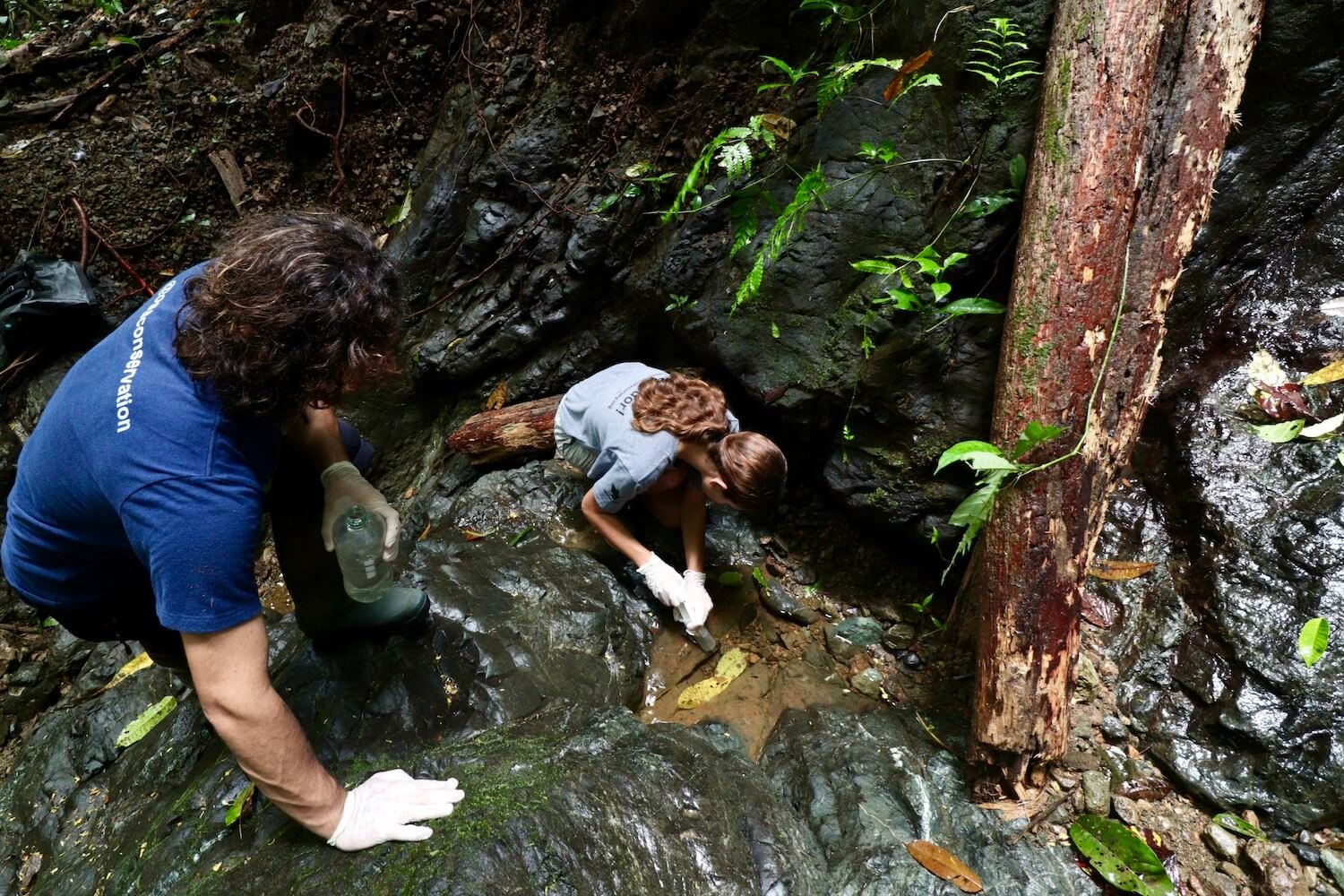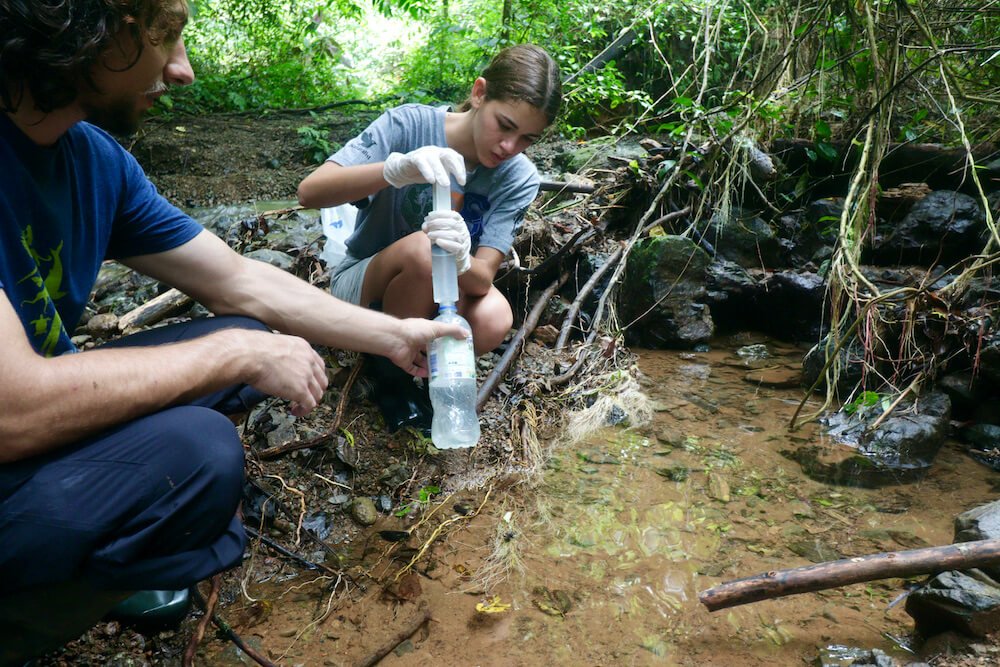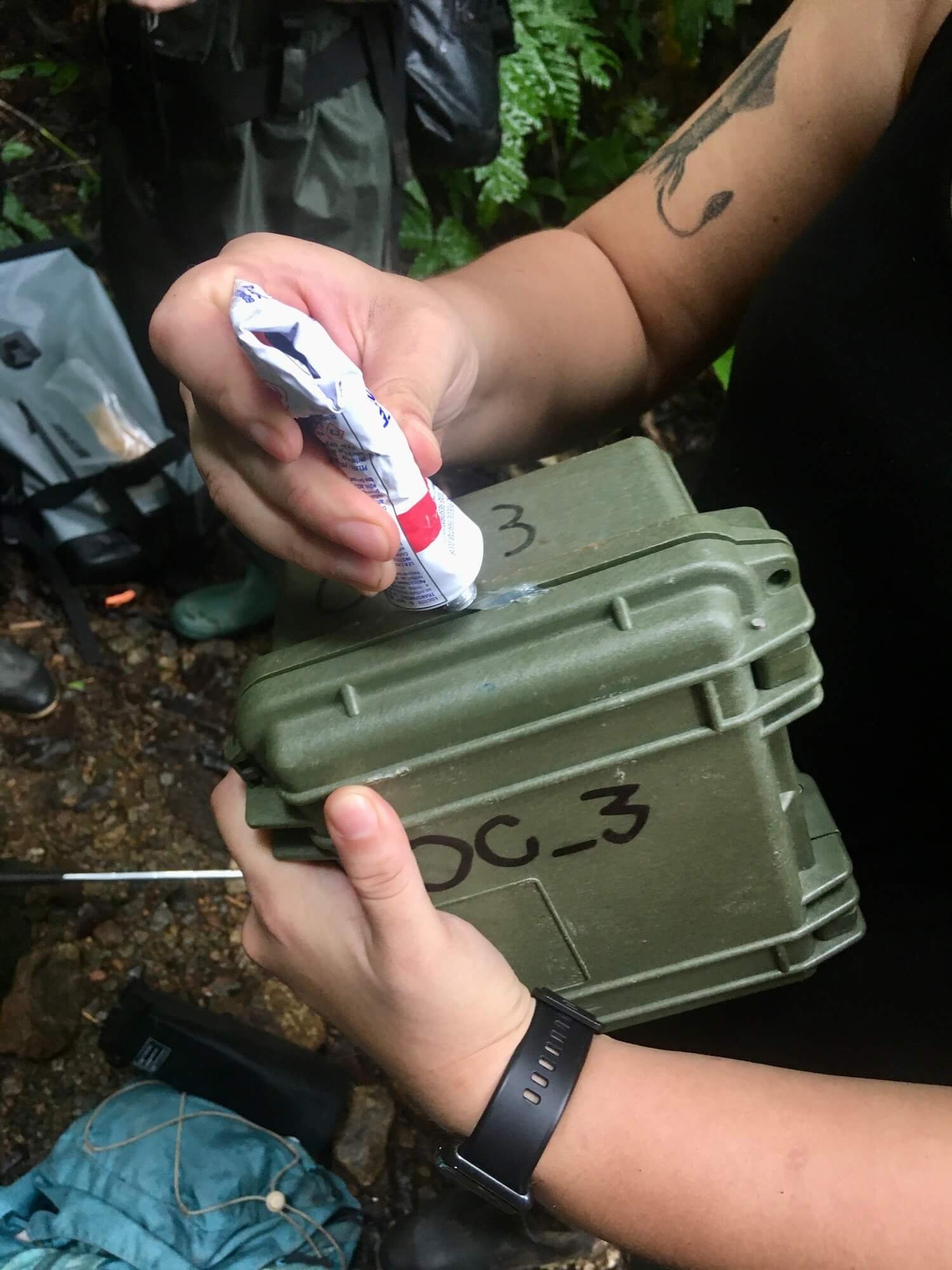The Call of the Endangered Frog
told by Marie (Resident Naturalist from Durham University)
We have been fortunate enough to have Osa Conservation continue their groundbreaking work aimed at understanding more about the Golfodulcean Poison Dart Frog (Phyllobates vittatus). This striking amphibian is endemic to the region around Golfo Dulce but spotting it can be difficult as populations are believed to be decreasing due to the loss of intact rainforest. However, the private rainforest reserve of Golfo Dulce Retreat is one of a handful of places in the Osa Peninsula region where healthy populations are present. This means that our guests see this frog on most excursions to our private waterfall.
Golfo Dulce Poison Dart frogs are difficult to spot so you often hear them before seeing one. This is the typical calling of a male frog (video courtesy of Osa Conservation).
A healthy population of amphibians is crucial for the rainforest and frogs are an important indicator species of the health of the environment. This is because amphibians can breathe through their skin, making them especially vulnerable to surrounding toxins. A healthy population of Golfo Dulce Poison Dart Frogs really means that the forest surrounding our Retreat is healthy and can support a high level of biodiversity.
Frogs are important indicator species for the health of its rainforest habitat.
Golfo Dulce Poison Dart Frogs at Golfo Dulce Retreat display a striking pattern which warns off potential predators.
The project that Osa Conservation is now undertaking uses two monitoring methods aimed at locating this ‘needle in a haystack’: Environmental DNA (eDNA) sampling and Bioacoustic Monitoring. This project is essentially a comparative experiment: in areas where dart frogs are known to be, such as in the grounds of Golfo Dulce Retreat, which of these methods will more efficiently determine their presence?
Tadpoles are left in small water pools by the Golfo Dulce Poison Dart Frog males where they develop into froglets.
This Golfo Dulce Poison Dart Frog in the Osa Peninsula shows a different dorsal pattern (photo courtesy Osa Conservation).
The eDNA, if effective, would allow understanding of the frogs’ location. The bioacoustic monitoring project, on the other hand, could be vital for the long term conservation of the Golfo Dulce poison dart frog. The poison dart frog is endemic to the Piedras Blancas and Corcovado national parks. Across this area, dart frogs have adapted their behaviours to different sub-areas, leading to mutations in their calls. If they have different calls, then they cannot communicate despite being the same species. Understanding changes in their calls means understanding the challenges of re-introducing frogs to new areas (there is no point in re-introducing a dart frog that will not recognise other dart frogs!). Provided the bioacoustic monitoring is effective, analysis of recording will enable understanding of the dart frog’s behaviour and calls, as well as provide information on their whereabouts within the national parks.
As one of the current resident naturalists at Golfo Dulce Retreat, I was able to join the biologists Sam (a frog lover and specialist in bioacoustic monitoring) and Myles (a specialist in eDNA) at the waterfall, on their quest for the dart frog. We hiked to the waterfall, which is one of a dozen destinations the biologists have visited to take samples for their study.
The waterfall in primary rainforest at Golfo Dulce Retreat provides ideal conditions for Golfo Dulce Poison Dart Frogs.
A Golfo Dulce Poison Dart Frog is carefully examined by Osa Conservation scientist Samantha.
The two research methods were very different: the eDNA sampling required finding 4 separate still water pools and extracting water samples. These water samples, once analysed, will tell whether there is presence or absence of the dart frog in the area. The effectiveness of this method (whether it successfully determines presence or absence) will then be assessed upon arrival of results.
Osa Conservation biologist Myles and Mia from the GDR Family check a still water pool for environmental DNA studies.
Samples of water are taken to check the effectiveness of eDNA in determining the presence of the Golfo Dulce Poison Dart Frog.
Bioacoustic monitoring was a very different venture. It required frogs to be located in the first place; it took around 3 hours to find four frogs! Four different monitors were placed within the vicinity of the frogs. They recorded for one month at hourly intervals (5 minutes every hour, between the time of 9am to 9pm). The recordings will be analysed in order to see whether effective recordings of the frogs were provided, and if so, whether the frequency of these calls could be studied.
A bioacoustics monitoring device is sealed to protect it from the heavy rainforest rains.
This pristine riverine habitat at Golfo Dulce Retreat is rich in biodiversity including the endemic Golfo Dulce Poison Dart Frog.
The biologists returned one month later to collect the bioacoustics monitors and more water samples. Whilst the eDNA results have been mixed, it has been found from the bioacoustic samples that the Golfo Dulce dart frog’s calls were indeed effectively captured by the recording devices. On top of this success, it was found that their calls are emitted at a higher frequency than other dart frogs. This has confirmed the fact that across the national parks, the dart frogs’ calls have adapted to local conditions, in our case the high background noise created by the waterfall. Uncovering this has therefore enabled further understanding of the challenges of reintroduction of dart frogs across the Piedras Blancas and Corcovado National Parks. If you would like to find out more information about Osa Conservation’s valuable work, please visit their website at www.osaconservation.org.
Further reading on this topic:
Creatures Great and Small: Golfodulcean Poison Frog
Jungle Blogs: In search of the endangered frog
Rainforest Excursions: Waterfall Expedition










